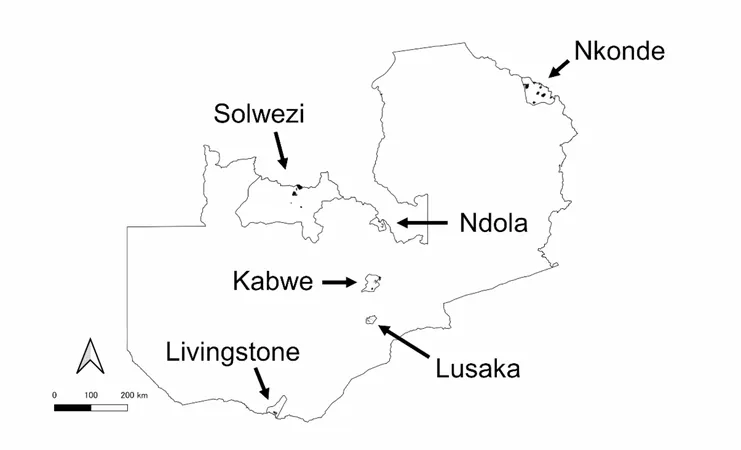
Geographic Factors Driving SARS-CoV-2 Spread in Zambia: A Closer Look at the First Wave
2025-01-10
Author: Yu
Introduction
The COVID-19 pandemic has highlighted how geographical factors significantly influence the spread of infectious diseases. In Zambia, SARS-CoV-2, the virus responsible for COVID-19, exhibited distinct transmission patterns influenced by a mix of geographic and societal elements. By exploring these dynamics, public health officials can tailor their surveillance and response efforts more effectively, particularly during subsequent pandemic waves.
Study Overview
A pivotal study conducted in July 2020 during the first wave of the pandemic examined the link between geographical factors and the prevalence of SARS-CoV-2 across six districts in Zambia—Lusaka, Kabwe, Livingstone, Ndola, Nakonde, and Solwezi. In a thorough analysis involving 96 Standard Enumeration Areas (SEAs), researchers aimed to uncover how characteristics such as urban living, socioeconomic status, and access to water and sanitation impacted the virus's prevalence.
Methodology
Researchers collected data from randomly selected households across urban and rural SEAs to calculate the prevalence of SARS-CoV-2 using PCR tests. Factors such as population density, socioeconomic status (SES), literacy rates, and access to water, sanitation, and hygiene (WASH) facilities were meticulously analyzed. These factors were mapped out using advanced geographical information systems (GIS) to visualize their distribution across the regions studied.
Key Findings
The study revealed alarming disparities in SARS-CoV-2 prevalence. The median infection rate across the 96 SEAs was 41.7 infections per 1,000 individuals. Urban areas specifically bore the brunt, reporting a median incidence of 52.1 infections compared to just 21.3 in rural localities. Importantly, the data indicated that higher SES vulnerability correlated with lower COVID-19 prevalence, suggesting that wealthier populations, especially in urban centers with inadequate WASH facilities, were more susceptible to higher infection rates.
Further analysis indicated that poor access to essential hygiene resources significantly heightened the risk of infection. Households lacking basic soap and those requiring substantial time to fetch water exhibited greater prevalence rates, underscoring the need for improved WASH accessibility during health crises.
Implications for Public Health Strategy
These findings have crucial implications for public health strategies in Zambia and beyond. Given the rapid transmission of SARS-CoV-2 in urban centers, targeted surveillance and proactive measures are vital for curbing further outbreaks. The study encourages a dual approach of enhancing WASH access alongside ongoing education about hygiene practices to reduce transmission rates.
The rising prevalence of COVID-19 in urban areas potentially stemmed from international travel associated with affluent communities. This underscores the need for robust monitoring of travel-related cases, particularly as global mobility increases.
Conclusion
The geographic factors influencing SARS-CoV-2 spread during Zambia's first COVID-19 wave are starkly evident. Urban-centric analyses reveal heightened vulnerabilities tied to socioeconomic disparities and inadequate sanitation facilities. As the nation continues its battle against COVID-19, lessons from initial waves highlight the urgency of integrating geographic insights into public health frameworks to better equip for future waves and pandemics.
In summary, the evidence presented emphasizes a critical need for comprehensive interventions across varied geographic sectors, targeting those most at risk and ensuring health resources, including hygiene facilities, are equitably distributed. With improved strategies and heightened awareness, nations can better prepare to mitigate not only COVID-19's effects but also future health crises.


 Brasil (PT)
Brasil (PT)
 Canada (EN)
Canada (EN)
 Chile (ES)
Chile (ES)
 Česko (CS)
Česko (CS)
 대한민국 (KO)
대한민국 (KO)
 España (ES)
España (ES)
 France (FR)
France (FR)
 Hong Kong (EN)
Hong Kong (EN)
 Italia (IT)
Italia (IT)
 日本 (JA)
日本 (JA)
 Magyarország (HU)
Magyarország (HU)
 Norge (NO)
Norge (NO)
 Polska (PL)
Polska (PL)
 Schweiz (DE)
Schweiz (DE)
 Singapore (EN)
Singapore (EN)
 Sverige (SV)
Sverige (SV)
 Suomi (FI)
Suomi (FI)
 Türkiye (TR)
Türkiye (TR)
 الإمارات العربية المتحدة (AR)
الإمارات العربية المتحدة (AR)